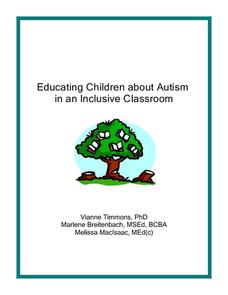Keep Your Children Safe
Fleeting Happiness
Shed light onto the subject of happiness with a worksheet that focuses on how the emotion—much like other emotions—does not last forever. Scholars read brief passages and answer nine short-answer questions that examine their personal...
Teach Engineering
Aerogels in Action
Model an oil spill cleanup. An engaging engineering lesson has groups using aerogels to simulate an oil spill cleanup (vegetable oil in water). Along the way, they learn about nanotechnology and hydrophilia/hydrophobia.
Teach Engineering
Accelerometer: Centripetal Acceleration
Scholars build robotic arms that swing back and forth and use them to collect velocity and acceleration data. To analyze the results, pupils compare data to the equations for angular velocity and centripetal acceleration.
Curated OER
Educating Children about Autism in an Inclusive Classroom
How do we meet the needs of learners with autism? Find out with an in-depth study that offers a thorough explanation of autism—what it is and how unique every individual's case may be, nine lesson plans spanning from kindergarten to 12th...
Code.org
Keys and Passwords
Scholars explore the relationship between cipher keys and passwords and as they learn more about the Vigenere cipher and continue to read from the book Blown to Bits in the seventh instructional activity of the series. They conduct an...
Teach Engineering
Engineers Love Pizza, Too!
Help overcome challenges in eating pizza. Scholars work in groups to design a device that assists a physically handicapped person eat pizza. They build a prototype of such a device to test their designs before building. To finish, groups...
Teach Engineering
Designing a Sustainable Guest Village in the Saguaro National Park
Brainstorm ideas to design a sustainable guest village in the Sonoran Desert. The first installment of a nine-part unit teaches young environmental scientists about the basics of the Saguaro National Park and about sustainable design....
Teach Engineering
Computer Simulation of the Sonoran Desert Community
See how changes in initial populations and parameters affect a biological community. Individuals use a special software program to simulate a desert community with five species. They adjust initial populations to see how the community...
Teach Engineering
Building a Piezoelectric Generator
In pairs, learners build a piezoelectric generator from readily available electric components in the second and final installment of the two-part series. Tapping the piezoelectric element produces enough electricity to light an LED....
Science Matters
Earthquake Preparedness
Forty-five states and territories in the USA are at moderate to very high risk of earthquakes. The discussion-based lesson covers what to do before, during, and after an earthquake. The 14th lesson in the series includes how to prepare a...
Texas Education Agency (TEA)
Romanesque Period
What defines architecture from the Romanesque Period? The last installment of an 11-part unit on architecture focuses on elements and examples of Romanesque architecture. Scholars complete a review worksheet after viewing a PowerPoint...
Overcoming Obstacles
Clarifying Values
Encourage thoughtful decision making with a instructional activity that highlights the importance of values. Scholars take part in a grand conversation, listen to stories, and make decisions based on their personal values.
Cornell University
What is IPM?
Discover what a pest is and how to identify one with a lesson that looks closely at our outside world and taxonomy. Scholars investigate insects and plants to practice their identification skills, take a survey, and explore the...
Cornell University
Insect IPM
Find out the characteristics that makes a bug an insect with a workbook designed to inform scholars about the crawly creatures that live around us. Scholars complete an ant-themed word search, answer questions using a solution key, and...
Cornell University
Weed IPM
Go on a weed hunt! Scholars gain insight into the characteristics of plants and examine the outdoor environment in order to identify five different types of weeds. Learners then show what they know with a one-page reflection.
Cornell University
Field Day: Be an IPM Detective
Become a pest detective! Individually or in small groups, scholars scout the land to discover which pests—plant and animal—inhabit it, determine whether the pests are endangering the environment, and summarize their findings.
Read Works
The Boy Who Cried Wolf
Reinforce reading comprehension strategies and contemplate an important life lesson with a worksheet featuring Aesop's fable, The Boy Who Cried Wolf. After reading a brief passage, scholars show what they know by way of five...
Constitutional Rights Foundation
Educating About Immigration The DREAM Act
Group members role play state legislators, supporters of and opponents to the The DREAM Act (Development, Relief, and Education for Alien Minors). After listening to the arguments put forth for and against the immigration legislation,...
Scholastic
I Survived Being Bullied
Listen, or read, to a first-hand account of how 15-year old Adama survived being bullied. Scholars gain insight into Adama's experience while reinforcing reading comprehension and vocabulary skills using context clues.
Curated OER
Arabia: Educator's Resource and Activity Guide
MacGillivray Freeman's film Arabia presents viewers with remarkable images and insights into this ancient and mysterious land. An educator's guide is designed to provided teachers with the materials they need to support a showing of the...
Learning to Give
Why Volunteer?
Inspire scholars to volunteer their time to make a positive change in their community. With help from research, a public speaker, and reflection, learners define and asses what it takes to be a volunteer in a business, non-profit,...
Learning to Give
Create a Volunteer Spirit
Motivate young citizens to make a positive difference through volunteering. Scholars examine the local and school community to discover ways the class, as a whole, can volunteer their time to help one or the other, then reflect on their...
Curriculum Corner
Bugs and Flowers Math and Literacy Centers
The sun shines, flowers bloom, and bugs fly—it must be Spring! Add a cheerful theme of bugs and flowers to math and literacy centers. Scholars take part in an assortment of activities designed to reinforce concepts such as identifying...
Harper Collins
Let the Wild Rumpus Start!
Accompany a reading of the story, Where the Wild Things Are by Maurice Sendak, with an activity booklet featuring five worksheets created to continue to the learning experience. Scholars solve a maze, draw a picture, search for Max,...
Other popular searches
- Boston Tea Party Invitation
- Letter Writing Invitation
- Writing Invitations
- Writing an Invitation
- Birthday Invitations
- Invitation Writing
- Creating an Invitation
- Esl Writing Invitation
- Making Invitations
- Party Invitations
- Teacher Letter of Invitation
- Spanish Invitations

























